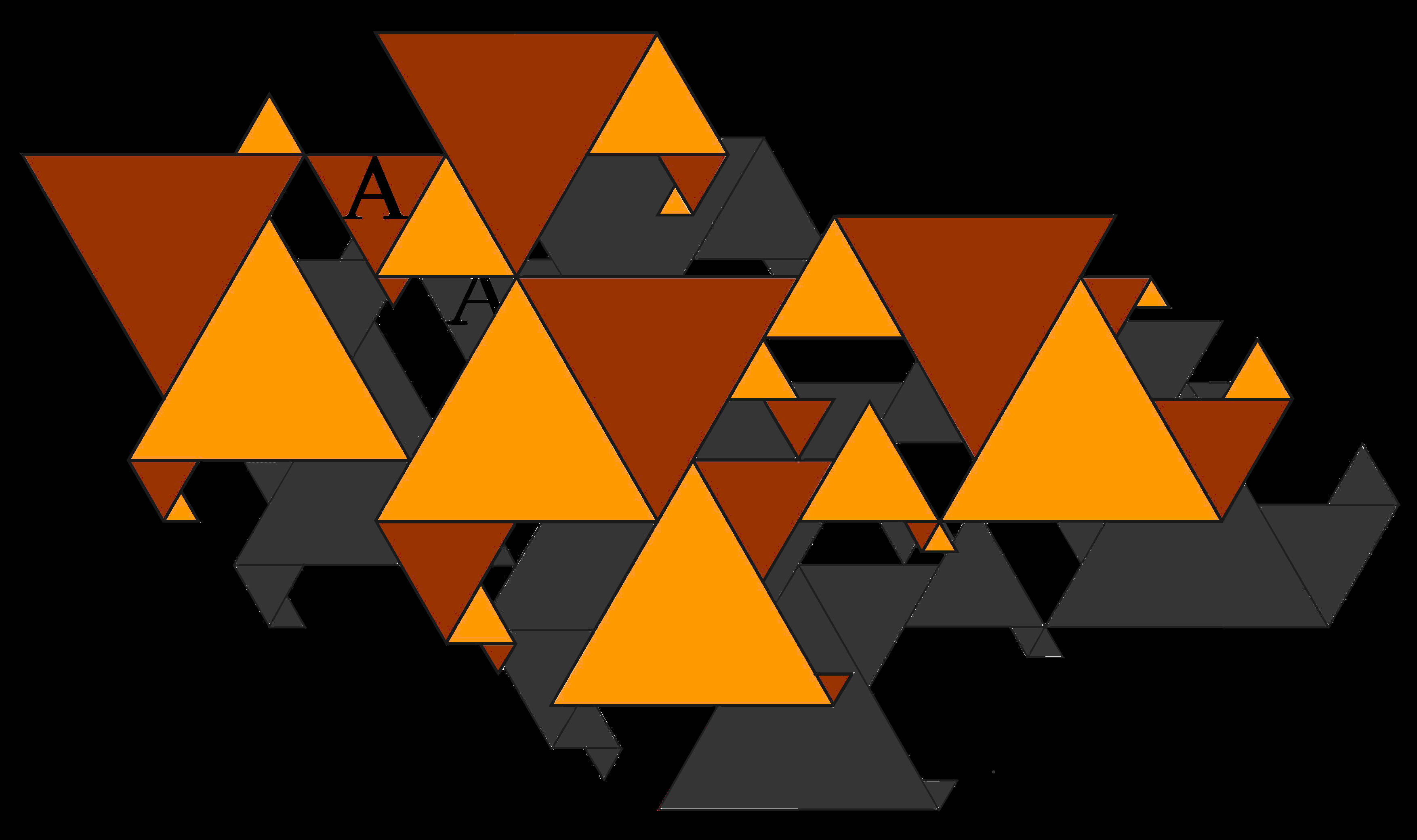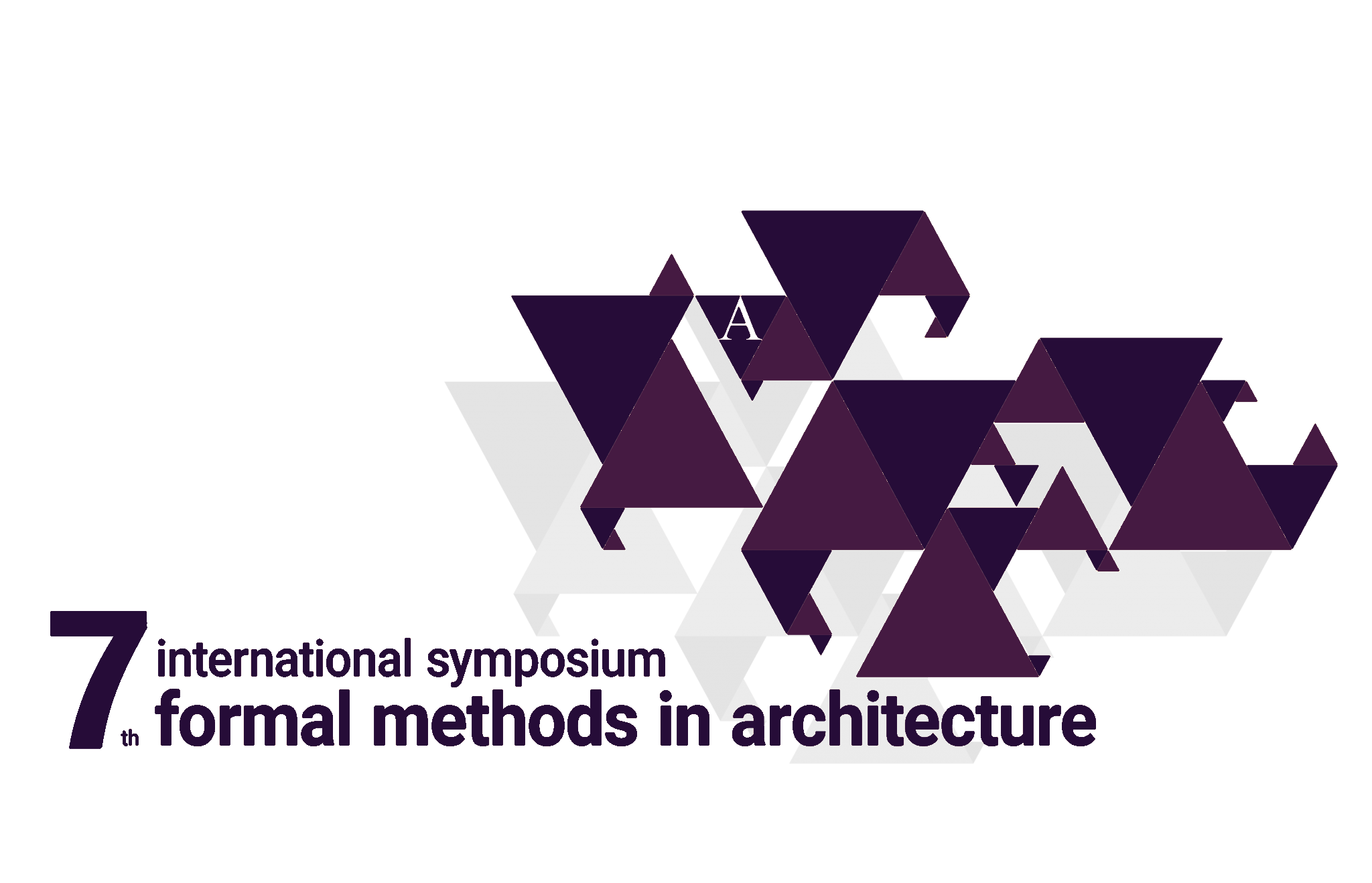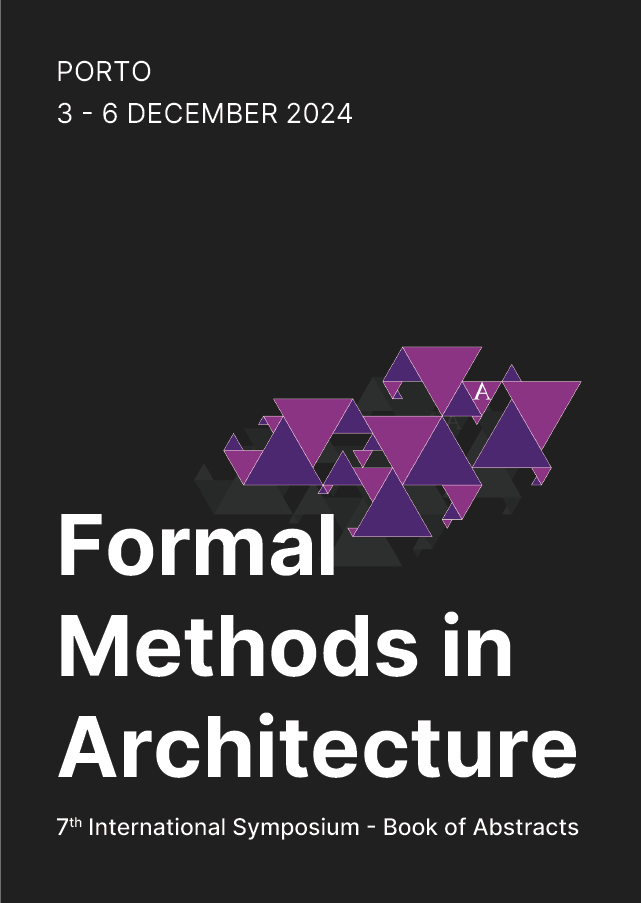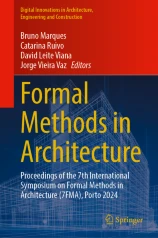
FMA SYMPOSIA series (2011-2026)
Formal Methods in Architecture

FMA SYMPOSIA series (2011-2026)
Formal Methods in Architecture
7th Symposium
PORTO 2024
2024-12-03 / 2024-12-06


Publisher: ESAP - Escola Superior Artística do Porto
Editors: Bruno Marques, Catarina Ruivo, David Leite Viana, Jorge Vieira Vaz
Date: December 2024
ISBN: 978-989-53723-7-9
Pages: 133
Editors:
Bruno Marques
OA-SRN - Ordem dos Arquitetos secção regional Norte
Catarina Ruivo
Dinâmia’CET – ISCTE-IUL Instituto Universitário de Lisboa
David Leite Viana
Information Sciences, Technologies and Architecture Research Centre, ISCTE-University Institute of Lisbon
Jorge Vieira Vaz
Research Laboratory in Architecture and Design, Porto Higher Art School
Graphic Designer:
Catarina Ruivo
Dinâmia’CET – ISCTE-IUL Instituto Universitário de Lisboa
| Page | Title | Authors |
|---|---|---|
| 19 | Additive Construction on Earth and beyond: from research to practical applications | José Pinto Duarte |
| 22 | Syntopy: An integrated approach to geometry, topology, and semantics | Wassim Jabi |
| 24 | Shapes of Intelligible Space, or, Spaces of Intelligible Shapes? | Tasos Varoudis |
| 26 | Urban morphometrics and Evidence-Based Design | Meta Berghauser Pont |
| 28 | The role of AI in the future of society, the city, construction and architecture | Franklim Morais |
| 34 | Plot systems and adaptation: a method for analysing space and time | Lais Bertolino Vítor Oliveira |
| 35 | Deciphering Urban Morphogenesis: A Morphospace Perspective | Caio Cacholas Daniel Lenz Dries Daems Fabiano Lemes Ribeiro HOWARD DAVIS Vinicius de Moraes Netto 2 |
| 37 | Co-learning between research and practice in planning: adressing the physical form of cities | Ana Mélice Dias Vítor Oliveira |
| 39 | Can topography favour the competitiveness of pedestrian over car? | Álvaro Costa Miguel Lopes Nuno Miguel de Sousa gomes Vítor Oliveira |
| 43 | Visualizing Urban Experience: AI and Computer Vision Framework for Historic Commercial Streets in Egypt | Nabil Mohareb |
| 44 | Space Syntax as an agent based system. NEtlogo framework proposal. | Ana Cocho Bermejo Dave De Jonge |
| 46 | Analyzing the Network Effects of Vertically Layered Urban Structures on Pedestrian Movement: A Case Study of the Mostar Interchange in Belgrade | Aleksandra Djukic Nikola Mitrovic |
| 50 | The Effect of Potential Urban Elements on Finding Direction in Urban Space Exampling Of Kadiköy- Yeldegirmeni, Istanbul,Turkey | Buse ERKAN Mehmet Emin Salgamcioglu |
| 52 | Formalization and Education in Architectural and Urban Design: Their Hermeneutic Dimensions | Carmen Escoda JOSEP MUNTAÑOLA MAGDA SAURA Margaret Krawecka Regina Garcia |
| 54 | Reimagining Digitalized Space: Integrating Meaning and Technology in Building Systems | Kaiko Kivi |
| 56 | Reimagining Human-Nature Coexistence: An Integrative Approach to Architectural Design with Biomimicry, Generative Modeling, and AI | Carina Oliveira Filipa Peres Crespo Osório Leonor Marques Mário Domingos Mário Ribeiro Manaia Mauro Costa Couceiro |
| 61 | Architecting the Metaverse: A Paradigm Shift in Architecture Co-Design | Micaela Raposo Nuno Pereira da Silva Sara Eloy |
| 63 | AI-DRIVEN VISUAL GENERATION: GENERATIVE ADVERSARIAL NEURAL NETWORK (GAN) AND DIFFUSION MODELS. | Pedro Meira-Rodríguez Vicente López Chao |
| 64 | Advancing Architectural Visualization: Boosting Scale and Reality with Augmented Reality | Chul Min Yeum Jason Su |
| 68 | From Brush to AI: How Tools Have Transformed Architectural Paradigms | Ashik Vaskor Mannan M. Arefeen Ibrahim |
| 69 | On the experience of architectural spaces: A pedagogical experiment using game engines | Efrosini Charalambous |
| 71 | Geographic Information Systems (GIS) in Architecture and Urbanism Education | Joaquim Flores |
| 76 | A category-theoretic formalism for architectural design generation: a parametric modelling demonstration | Anders Ang Aries Yang Jielin Chen Rudi Stouffs |
| 78 | Leveraging graph-based machine learning to represent and generate architectural layouts | Anders Ang Aries Yang Jielin Chen Rudi Stouffs |
| 80 | Assembler – a tool for computational decision at scale in combinatorial generation of architectural spaces | Alessio Erioli |
| 82 | Automated Two-Story Floor Plan Generation using Generative Adversarial Networks | Berfin Yildiz Gulen Cagdas Ibrahim Zincir |
| 84 | From text to 3D models: Utilizing Large Language Models in Grasshopper for automating scripting and algorithmic design workflows | Miltiadis Katsaros Styliani (Stella) Salta |
| 88 | Connecting Spaces and People: Point Cloud Segmentation in the Context of Design Anthropology | Amina Rezoug |
| 90 | Integrating Additive Manufacturing with BIM: A Case Study in Sustainable Architecture and Construction | Bárbara Rangel Jaime Cunha |
| 92 | Exploring Photogrammetry’s Creative Potential in Nature Driven Architecture Design | Francisco Scotti Pedro de Azambuja Varela |
| 99 | Comparing Anthropogenic Water Risks from Climate Change in London and Kolkata | Tazyeen Alam |
| 101 | Towards a Unified Informatic Model for Cognitive Buildings: Integrating BIM, Actor Models, and Dynamic Fault Trees using Bigraphical Reactive Systems | P Govind Raj Subrat Kar |
| 103 | Formal methods in flood disaster response: the case of Porto Alegre, Brazil | Ana Paula Dalcin Camilla Pezzica Clarice Bleil de Souza DIEGO ALTAFINII Guilherme Marques |
| 105 | ReLighting Spaces -Training daylight access cognition in combinatorial spatial assemblages using Reinforcement Learning | Alessio Erioli Giuseppe Massafra |
| 107 | Reassembling Waste: Towards a Carbon Zero Built Environment | Inês Caetano Luis Santos |
| 109 | Optimizing Sustainability through digital tools: Energy and Carbon Comparative Analysis of Brick, Concrete and Wood Frame Constructions in Coimbra Residences | Leonor Domingos Ricardo Resende Sara Margarida Cabral Parece |
| 113 | Computational Proportional Analysis of Inner Residential Spaces in Seventeenth-Century Bastion Castles | Olha Tikhonova |
| 114 | Exploring Variability Within 3D Shape Collections of Facade Panels of Modernist Multifamily Buildings in New Belgrade: A Methodological Framework | Djordje Djordjevic Djordje Mitrovic Mirjana Devetakovic |
| 117 | Neuroaesthetic Measures of High-Rise Housing Facades | Audrey Xu Immanuel Koh |
| 118 | Kahn’s Two Houses: From Formal Analysis to Animated Synthesis | Heather Ligler |
| 123 | Parametric Software and the Architectural Design | Bruno Marques Darlene julio |
| 125 | In-formation: shaping tools, composition rules, visual thinking and the creative processes | Gonçalo Castro Henriques Marcio Nisenbaum Tatiana Teixeira |
| 127 | Combining space syntax and kernel methods in the delimitation of the Matosinhos Urban Pressure Zone | David Leite Viana João Quintão Rui Fernandes |

Publisher: Springer Nature Switzerland
ISBN Hardcover: 978-3-032-02781-8
ISBN Softcover: 978-3-032-02784-9
ISBN eBook: 978-3-032-02782-5
Pages: XIX, 737
Ilustrations: 195 b/w illustrations, 194 illustrations in colour
Editors:
Bruno Marques
OA-SRN - Ordem dos Arquitetos secção regional Norte
Catarina Ruivo
Dinâmia’CET – ISCTE-IUL Instituto Universitário de Lisboa
David Leite Viana
Information Sciences, Technologies and Architecture Research Centre, ISCTE-University Institute of Lisbon
Jorge Vieira Vaz
Research Laboratory in Architecture and Design, Porto Higher Art School
| v | Preface | Bruno Marques Catarina Ruivo David Leite Viana Jorge Vieira Vaz |
| xiii | Closing Speech of the 7FMA | Catarina Ruivo |
| 3 | TopologicPy: a Syntopic Integration of Geometry, Topology and Semantics in Architectural Design | Wassim Jabi |
| 9 | AI and architecture | Franklim Morais |
| 43 | Deciphering Urban Morphogenesis: A Morphospace Perspective | Caio Cacholas Daniel Lenz Dries Daems Fabiano Lemes Ribeiro HOWARD DAVIS Vinicius de Moraes Netto 2 |
| 66 | Co-learning between research and practice in planning: adressing the physical form of cities | Ana Mélice Dias Vítor Oliveira |
| 78 | Combining space syntax and kernel methods in the delimitation of the Matosinhos Urban Pressure Zone | David Leite Viana João Quintão Rui Fernandes |
| 102 | Adaptation of Plot systems: a method for analysing space and time | Lais Bertolino Vítor Oliveira |
| 118 | Measuring the impact of urban structures shaped by topography on the competitiveness between car and pedestrian: a GIS simulation on Salvador vs San Francisco | Álvaro Costa Miguel Lopes Nuno Miguel de Sousa gomes Vítor Oliveira |
| 136 | Advancing Spatial Cognition Analysis: Integrating Agent-Based Modelling with Space Syntax in the NetLogo Framework | Ana Cocho Bermejo Dave De Jonge |
| 158 | Visualizing Urban Experience: AI and Computer Vision Framework for Historic Commercial Streets in Egypt | Nabil Mohareb |
| 179 | The Effect of Potential Urban Elements on Finding Direction in Urban Space Exampling Of Kadiköy- Yeldegirmeni, Istanbul,Turkey | Buse ERKAN Mehmet Emin Salgamcioglu |
| 207 | Reimagining Human-Nature Coexistence: An Integrative Approach to Architectural Design with Biomimicry, Generative Modeling, and AI | Carina Oliveira Filipa Peres Crespo Osório Leonor Marques Mário Domingos Mário Ribeiro Manaia Mauro Costa Couceiro |
| 218 | Reimagining Digitalized Space: Integrating Meaning and Technology in Building Systems | Kaiko Kivi |
| 232 | Parametric Software to Support Architectural Design strategies | Bruno Marques Darlene julio |
| 243 | Optimizing Sustainability through digital tools: Energy and Carbon Comparative Analysis of Brick, Concrete and Wood Frame Constructions in Coimbra Residences | Leonor Domingos Ricardo Resende Sara Margarida Cabral Parece |
| 261 | Reassembling Waste: Towards a Carbon Zero Built Environment | Inês Caetano Luis Santos |
| 281 | Advancing Architectural Visualization: Boosting Scale and Reality with Augmented Reality | Chul Min Yeum Jason Su |
| 300 | Architecting the Metaverse: A Paradigm Shift in Architecture Co-Design | Micaela Raposo Nuno Pereira da Silva Sara Eloy |
| 319 | From Brush to AI: How Tools Have Transformed Architectural Paradigms | Ashik Vaskor Mannan M. Arefeen Ibrahim |
| 335 | A category-theoretic formalism for architectural design generation: a parametric modelling demonstration | Anders Ang Aries Yang Jielin Chen Rudi Stouffs |
| 352 | Assembler – a tool for computational decision at scale in combinatorial generation of architectural spaces | Alessio Erioli |
| 370 | ReLighting Spaces -Training daylight access cognition in combinatorial spatial assemblages using Reinforcement Learning | Alessio Erioli Giuseppe Massafra |
| 390 | A Layered Graph Framework for Generative Architectural Design: Exploring DGMG and GraphGPT Models for Building Footprint Generation | Anders Ang Aries Yang Jielin Chen Rudi Stouffs |
| 410 | Automated Two-Story Floor Plan Generation using Generative Adversarial Networks | Berfin Yildiz Gulen Cagdas Ibrahim Zincir |
| 430 | PromptMorph: LLM-Driven Workflow for Text-to-3D Parametric Modeling in Architecture | Miltiadis Katsaros Styliani (Stella) Salta |
| 456 | Ai-driven Visual Generation: Generative Adversarial Neural Network (GAN) and Diffusion Models | Pedro Meira-Rodríguez Vicente López Chao |
| 473 | Towards a Unified Informatic Model for Cognitive Buildings: Integrating BIM, Actor Models, and Dynamic Fault Trees using Bigraphical Reactive Systems | P Govind Raj Subrat Kar |
| 495 | Comparing Anthropogenic Water Risks from Climate Change in London and Kolkata | Tazyeen Alam |
| 517 | Formal methods in flood disaster response: the case of Porto Alegre, Brazil | Ana Paula Dalcin Camilla Pezzica Clarice Bleil de Souza DIEGO ALTAFINII Guilherme Marques |
| 543 | Exploring Photogrammetry’s Creative Potential in Nature Driven Architecture Design | Francisco Scotti Pedro de Azambuja Varela |
| 561 | Integrating Additive Manufacturing with BIM: A Case Study in Sustainable Architecture and Construction | Bárbara Rangel Jaime Cunha |
| 575 | Formalization and Education in Architectural and Urban Design: Their Hermeneutic Dimensions | Carmen Escoda JOSEP MUNTAÑOLA MAGDA SAURA Margaret Krawecka Regina Garcia |
| 592 | Computational Proportional Analysis of Inner Residential Spaces in Seventeenth-Century Bastion Castles | Olha Tikhonova |
| 612 | Neuroaesthetic Measures of High-Rise Housing Facades | Audrey Xu Immanuel Koh |
| 634 | Kahn’s Two Houses: From Formal Analysis to Design Synthesis | Heather Ligler |
| 651 | In-formation: shaping tools, composition rules, visual thinking and the creative processes | Gonçalo Castro Henriques Marcio Nisenbaum Tatiana Teixeira |
| 665 | Geographic Information Systems (GIS) in Architecture and Urbanism Education | Joaquim Flores |
| 678 | Exploring architectural experience: A pedagogical experiment with game engines | Efrosini Charalambous |